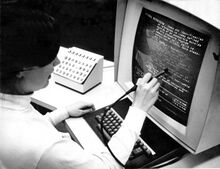Light pen

A light pen is a computer input device in the form of a light-sensitive wand used in conjunction with a computer's cathode-ray tube (CRT) display.
It allows the user to point to displayed objects or draw on the screen in a similar way to a touchscreen but with greater positional accuracy. A light pen can work with any CRT-based display, but its ability to be used with LCDs was unclear (though Toshiba and Hitachi displayed a similar idea at the "Display 2006" show in Japan[1]).
A light pen detects changes in brightness of nearby screen pixels when scanned by cathode-ray tube electron beam and communicates the timing of this event to the computer. Since a CRT scans the entire screen one pixel at a time, the computer can keep track of the expected time of scanning various locations on screen by the beam and infer the pen's position from the latest time stamps.
History
The first light pen, at this time still called "light gun", was created around 1951–1955 as part of the Whirlwind I project at MIT, where it was used to select discrete symbols on the screen,[2][3][4][5] and later at the SAGE project, where it was used for tactical real-time-control of a radar-networked airspace.[3]
One of the first more widely deployed uses was in the Situation Display consoles of the AN/FSQ-7 for military airspace surveillance. This is not very surprising, given its relationship with the Whirlwind projects. See Semi-Automatic Ground Environment for more details.
During the 1960s, light pens were common on graphics terminals such as the IBM 2250 and were also available for the IBM 3270 text-only terminal.
Because the user was required to hold their arm in front of the screen for long periods of time (potentially causing "gorilla arm") or to use a desk that tilts the monitor, the light pen fell out of use as a general-purpose input device.[citation needed] Light pen was also perceived as working well only on displays with low persistance, which tend to flicker.[6]
See also
Notes
References
- ↑ "Slashphone Article". 2006-04-20. http://www.slashphone.com/69/4156.html.
- ↑ Metropolis, Nicholas Constantine, ed (1980). "Whirlwind". A History of Computing in the Twentieth Century. p. 375.
- ↑ 3.0 3.1 "2. Lightpen and Joystick". Fire-Control and Human-Computer Interaction: Towards a History of the Computer Mouse (1940–1965). Mindell, David. Massachusetts Institute of Technology, Program in Science, Technology, and Society. pp. 2–3 [2]. http://moon.zkm.de/hp_new/pdf/mouse.pdf. Retrieved 2021-08-24. (1+10 pages) (NB. This is based on an earlier German article published in 1996 in Lab. Jahrbuch 1995/1996 für Künste und Apparate (350 pages) by Kunsthochschule für Medien Köln mit dem Verein der Freunde der Kunsthochschule für Medien Köln; Buchhandlung Walther König|Verlag der Buchhandlung Walther König (de) in Cologne, Germany. ISBN:3-88375-245-2.)
- ↑ "A Critical History of Computer Graphics and Animation". http://design.osu.edu/carlson/history/lesson2.html.
- ↑ "The Computer Desktop Encyclopedia (entry for Light Pen)". http://lookup.computerlanguage.com/host_app/search?cid=C000401&term=light%20pen.
- ↑ "8. Video Access, part 1: Characters". Inside the IBM PC: access to advanced features and programming. Bowie, Maryland, USA: Brady. 1983. p. 164. ISBN 0-89303556-4. "The light pen isn't one of the more popular options for the IBM/PC. […] The light pen is in a kind of a bind — it can only be used with a display which has a very low persistance. […] But that kind of display screen tends to flicker to the eye. So a good display for the eye can't use a light pen, and a light pen display is harder on the eye. […]"
Cite error: <ref> tag with name "Amiga" defined in <references> is not used in prior text.
Cite error: <ref> tag with name "MSX_2019" defined in <references> is not used in prior text.
Cite error: <ref> tag with name "Sanyo" defined in <references> is not used in prior text.
Cite error: <ref> tag with name "Elliott_2020_MDA" defined in <references> is not used in prior text.
Cite error: <ref> tag with name "Elliott_2012_HGCPlus" defined in <references> is not used in prior text.
Cite error: <ref> tag with name "Elliott_2012_InColor" defined in <references> is not used in prior text.
<ref> tag with name "Kosmic_2023" defined in <references> is not used in prior text.External links
 |

